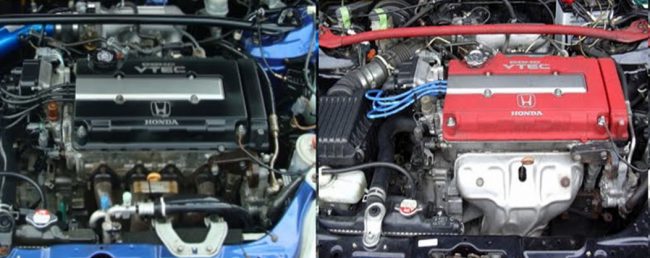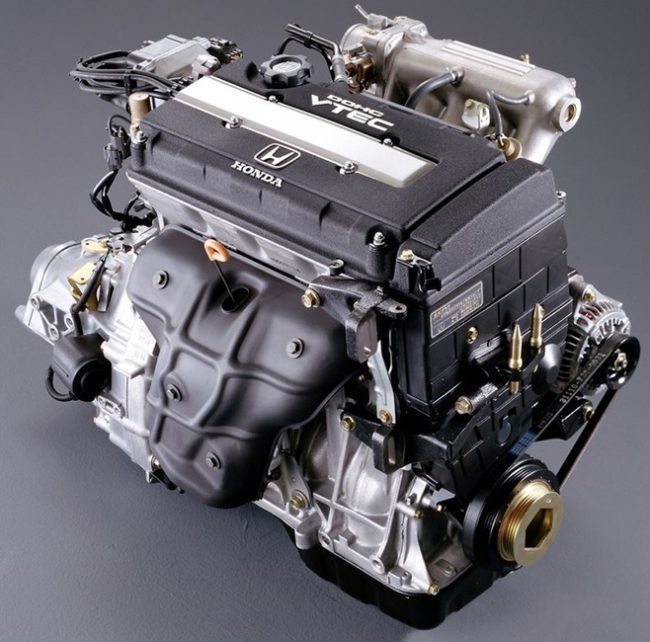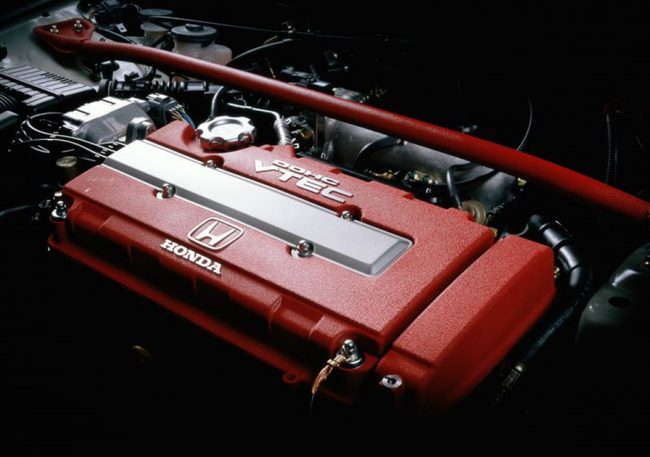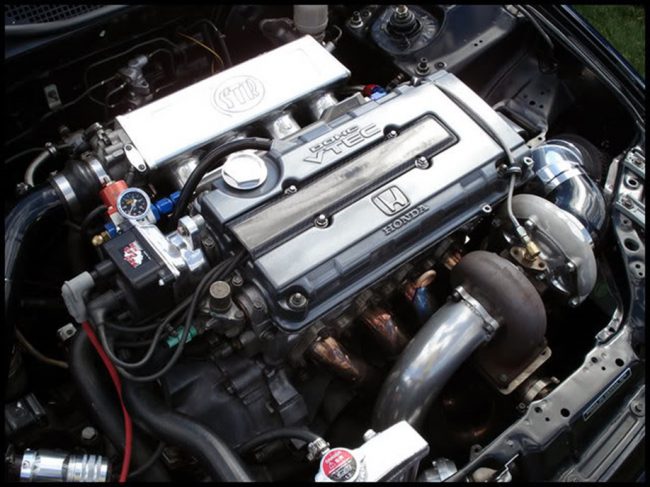
Honda B16A and B16B engines
One of its best units is B16, Honda Motor Co., Ltd. released back in 1989. The B16A and B16B with two camshafts were the first engines from which Honda engineers began to introduce their proprietary gas distribution system, called VTEC, into power plants. It was from that moment that the DOHC VTEC marking on the cylinder head cover became the hallmark of all forced internal combustion engines from the Japanese brand.
Cars that seemed to be aimed at the masses of consumers were equipped with engines that showed fantastic power and torque in relation to their volume. B16 gasoline engines made a huge resonance throughout the automotive world and turned out to be more technologically advanced than their many competitors, after which Honda began to be perceived as the manufacturer of the most advanced mini-sports cars.
The B16 has an aluminum BC that is 203mm high. Inside is a crankshaft with a 77 mm (77.4 mm - in modification B) piston stroke with a diameter of 81 mm. The compression height of the pistons is 30 mm. All this together made it possible to achieve from 150 to 170 hp. with a working volume of 1.6 liters.
In 2000, the B16 line finally left the Honda conveyor, however, to this day, the units of this series are in the top ten Japanese internal combustion engines.

*Engine numbers B16A/B are stamped on a special area of the cylinder block.
B16A

B16A with a volume of 1.6 liters, with a power of up to 170 hp. (at 7800 rpm) and with a maximum torque of 157 Nm (at 7300 rpm), was installed on Integra, Civic, Civic Ferio, CR-X and CR-X del Sol.
Two years after the introduction of the B16A, Honda introduced the world to the second generation of this engine with an increased compression ratio (10.4 units) and modified camshaft cam shapes. At the same time, the B16A powertrain migrated from Integra to other models, including those intended for the European market.
In the 16rd generation B3A engine, released in 1996, no changes were observed, however, as in subsequent versions of this modification. The technical characteristics remained practically unchanged, although it is possible that with each new generation the engine became more and more perfect.
B16A Features:
| Engine displacement, cc | 1595 |
| Power, hp | 150-170 |
| Maximum torque, N m (kg m) / rpm | 150 (15) / 6000 152 (16) / 7000 153 (16) / 6500 157(16)/7300 |
| Fuel consumption, l / 100 km | 4.9-5.4 |
| engine's type | in-line, 4-cylinder, 16-valve, DOHC |
| Cylinder diameter, mm | 81 |
| Maximum power, hp (kW)/r/min | 150 (110) / 7100 155 (114) / 7300 160 (118) / 7600 170 (125) / 7800 |
| Compression ratio | 10.4 |
| The piston stroke, mm | 77.4 |
| Models | Integra, Civic, Civic Ferio, CR-X, CR-X del Sol |
| Resource, outside. km | 300+ |
B16B

B16B with a volume of 1.6 liters, with a power of 185 hp. (at 8200 rpm) and with a maximum torque of 160 Nm (at 7500 rpm), was installed on the Civic Type R.
B16B Features:
| Engine displacement, cc | 1595 |
| Power, hp | 185 |
| Maximum torque, N m (kg m) / rpm | 160 (16) / 7500 |
| Fuel consumption, l / 100 km | 4.9-5.1 |
| engine's type | in-line, 4-cylinder, 16-valve, DOHC |
| Cylinder diameter, mm | 81 |
| Maximum power, hp (kW)/r/min | 185 (136) / 8200 |
| Compression ratio | 11 |
| The piston stroke, mm | 77 |
| Models | Civic Type R |
| Resource, outside. km | 300+ |
In 1998, Honda once again surprised the brand's fans with the release of the popular B16 B-engine, specially designed for the Civic TypeR, which raised the tachometer red zone to an impossible 9000 rpm.
Advantages and problems of B16A / B engines
B16A / B engines do not have any special “diseases” of their own, but after all, over time, any engine that has managed to roll back hundreds of thousands of kilometers begins to break down, this is inevitable. That is why it is so important to service the internal combustion engine on time.
pros
- Performance.
- Economical.
- Reliability.
Cons
- The high cost of repairs and original components.
- Lack of volume when driving long distances.
- High operating volume.
Replacing the timing belt drive on the B16A / B engine must be done after 100 thousand km, otherwise there is an option to be left without valves, although it can carry through at low speeds.
Valve adjustment on B16A / B should be carried out after 40 thousand km. The cold gaps are as follows: inlet - 0.15 mm, outlet - 0.19 mm.
Tuning Honda B16A
The simplest modification of the B16A, which can add 10-15 hp. consists in installing a cold inlet, a 4-1 type manifold and a 63 mm forward flow.
The intake manifold, camshafts, gears, lightweight intake valves and pistons from Type R + porting and Hondata brains, as well as proper tuning, will allow you to squeeze more than 16 hp out of the B200A.
Lightweight flywheel, Skunk2 S2 camshafts, 70mm throttle body, 340cc injectors, ACL bushing kit, ARP conrod bolts and studs, Supertech bronze valve guides and springs, titanium poppets, 12 pistons, spark plugs with kch 7, + high-quality engine tuning will give a total of more than 220 hp.
B16A turbo
Today, turbocharging is one of the most common options for boosting engines.
To implement the B16A turbocharged project, it will be necessary to install a TD05 turbine (with the organization of an oil supply and drain system), an intercooler and manifold, piping, wastegate and blow-off valves, a Walbro 255 fuel pump, a fuel pressure regulator, an AEM high-performance fuel rail (for enlarged injectors on 550cc), Skunk2 intake manifold, Type R geared camshafts, 63mm exhaust, SPZ and Hondata brains. After proper tuning, the stock bottom will hold about 300 hp, so it’s better to add forging for a compression ratio of 8.5-9, lightweight connecting rods, high-strength connecting rod bolts and studs from ARP, a set of ACL liners, and also strengthen the block itself and finalize it. head."


Conclusion
Honda is one of the few global automakers producing aspirated vehicles with more than a hundred "horses" per liter of internal combustion engine volume. Despite the impressive forcing, the B16 series engines are extremely reliable, as evidenced by the reviews of car owners. The red zone on the B16A tachometer starts at 8000, and on the B16B it starts at 9000 rpm, and this alone says a lot. The average fuel consumption in the city fluctuates in the range of 10-12 liters, and on the highway within - 7 liters, when driving at a speed of about 90 km / h.
Tuning the B16A without the use of turbines and boost systems is quite feasible, but a good turbocharged project will cost quite a lot, and only a few do such work.

